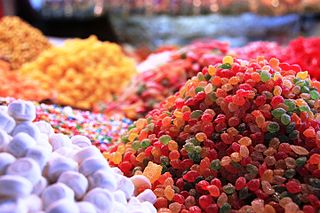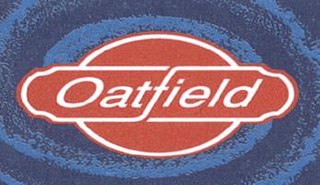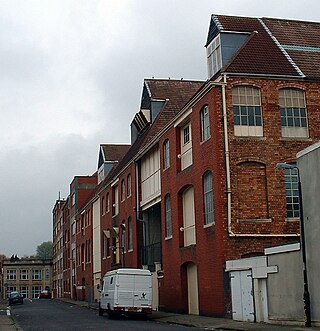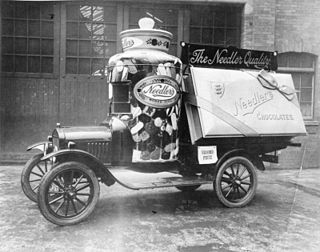
Confectionery is the art of making confections, which are food items that are rich in sugar and carbohydrates. Exact definitions are difficult. In general, however, confectionery is divided into two broad and somewhat overlapping categories: bakers' confections and sugar confections. The occupation of confectioner encompasses the categories of cooking performed by both the French patissier and the confiseur.

Candy, alternatively called sweets (BrE) or lollies, is a confection that features sugar as a principal ingredient. The category, called sugar confectionery, encompasses any sweet confection, including chocolate, chewing gum, and sugar candy. Vegetables, fruit, or nuts which have been glazed and coated with sugar are said to be candied.

The Heath bar is a candy bar made of toffee, almonds, and milk chocolate, first manufactured by the Heath Brothers Confectionery in 1928. Since its acquisition of the Leaf International North American confectionery operations late in 1996, the Heath bar has been manufactured and distributed by Hershey.

AS Kalev is an Estonian confectionery company. The company traces its origins back two hundred years, the business that preceded the Maiasmokk café was founded in 1806, and is now owned by Kalev. The Kalev company is the country's largest producer of sweets and a part of the industrial conglomerate Orkla Group. Kalev is based in Põrguvälja near Jüri, Rae Parish, Harju County.

A dragée, also known as a confetto or mulabbas, is a bite-sized confectionery with a hard outer shell.
Fannie May Confection Brands, Inc. is an American chocolate manufacturer headquartered in Chicago and currently owned by multinational company Ferrero SpA. Fannie May manufactures a broad variety of products including enrobed, barks, caramels, squares, berries, twist wrapped, molded, flow wrapped, and boxed chocolates. In attempt to reach all consumers, Fannie May became allergy conscious, carrying candy without gluten, milk, honey, oil(s), wheat, eggs, etc. The Union of Orthodox Jewish Congregations of America certified many of Fannie May's products to be kosher as well.
Frankford Candy & Chocolate Company is an American candy manufacturer, located in Philadelphia, Pennsylvania, founded in 1947 by Sam Himmelstein. The current CEO is Stuart Selarnick.

A confectionery store are stores that sell confectionery and the intended market is usually children. Most confectionery stores are filled with an assortment of sweets far larger than a grocer or convenience store could accommodate. They frequently provide a variety of international sweets and retro delicacies. Very often unchanged in layout since their inception, confectioneries are known for their warming and nostalgic feel.

The National Confectioners Association is an American trade organization that promotes chocolate, candy, gum and mints, and the companies that make these treats. NCA lobbies the American government in favor of the confectionery industry, evaluated at US$35 billion. Confections are produced in all 50 states. The association "annually hosts the National Candy Show in Chicago, as well as the Candy Hall of Fame". As of 2024, the Sweets and Snacks Expo will take place in Indianapolis.

The candy desk has been a tradition of the United States Senate since 1965, whereby a senator who sits at a particular desk near a busy entrance keeps a drawer full of candy for members of the body. The current occupant of the candy desk is Indiana Senator Todd Young.
Sanders Chocolates is an American brand of chocolates that was founded by Fred Sanders on June 17, 1875. According to company history, by the mid-20th century, the company operated 57 retail stores in the Great Lakes region, featuring counter service offering candy, fudge toppings, baked goods, light lunches and an assortment of desserts. Sanders is known for its bumpy cake and hot fudge cream puffs.

Oatfield was a chocolate and confectionery manufacturer located in Letterkenny, County Donegal, Ireland. The company was the oldest confectionery manufacturer in Ireland.

E. Wedel is a Polish confectionery company, which has been producing a variety of chocolates, cakes, and snacks since 1851. Wedel is also a well-recognized brand of candy in Poland, considered to be the "Polish national chocolate brand" in that market, and is the leading candy brand among Polish producers with about 14% of the Polish market in 2005 and 11.7% in 2007.

Elizabeth Shaw Ltd is a Bristol-based company owned by Colian Holding that markets chocolate-based confectionery, including the brands Famous Names Chocolate liqueurs and Elizabeth Shaw Mint chocolates. The modern company was formed from several mergers of well established confectionery companies, first by J A & P Holland and then by James Goldsmith in the 1960s as part of his creation of his food conglomerate Cavenham Foods.

Needler's was a sweet manufacturer based in Kingston upon Hull, England. The company was founded in the 19th century and sold to Hillsdown Holdings in 1986.
The Warrell Corporation is a confectionery and snack food manufacturing company based in Camp Hill, Pennsylvania.

Clear toy candy is a traditional confectionery that originated in Germany, England and Scotland. It is especially popular at Easter and Christmas. The hard candy is made in molds, in a multitude of fanciful shapes. The candy is tinted in bright colors, traditionally yellow, red and green. A stick is sometimes added before the candy completely cools to make a lollipop.

Winter ice cream is a Hungarian confectionery similar in appearance to ice cream in a cone, but traditionally having ganache or a similar kind of sweet cream filling with usually a chocolate-cocoa flavoring. It gained popularity in the 1970s in communist Hungary, being produced as a winter alternative to "summer" ice creams, which were deemed to be too cold for winter sweets. Apart from grocery shops, it was frequently sold as part of the national railway's catering service. The confectionery's popularity faded in the early 1990s, when, after the end of communism, foreign candy manufacturers and their products appeared on the Hungarian market. However, along with some other snack foods and soft drinks of communist-era Hungary, winter ice cream garnered renewed interest in the late 2000s and 2010s.

Chocolala Chocolate Museum is a specialty museum dedicated to the history of the Estonian chocolate industry. It is located in the Tallinn Old Town district near Freedom Square, Tallinn, Estonia.





















